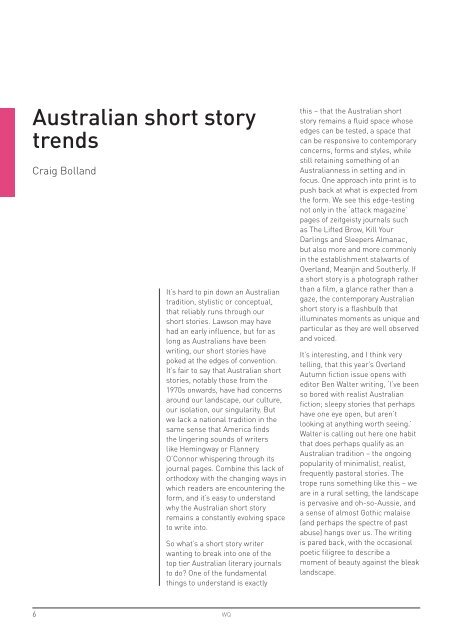Kristina Olsson
?r=MTAwMA0KDQoNCmM2ZDAwMDAwMDAwNjYwOQ0KaHR0cDovL3d3dy5xd2MuYXNuLmF1L2Fzc2V0cy9maWxlcy9XUU1hZ2F6aW5lL1dRJTIwSXNzdWUlMjAyNTUlMjAtJTIwZmluYWwucGRmDQp0cnVlDQptZWxpc3NhY3JhaWdhdXRob3JAZ21haWwuY29t
?r=MTAwMA0KDQoNCmM2ZDAwMDAwMDAwNjYwOQ0KaHR0cDovL3d3dy5xd2MuYXNuLmF1L2Fzc2V0cy9maWxlcy9XUU1hZ2F6aW5lL1dRJTIwSXNzdWUlMjAyNTUlMjAtJTIwZmluYWwucGRmDQp0cnVlDQptZWxpc3NhY3JhaWdhdXRob3JAZ21haWwuY29t
You also want an ePaper? Increase the reach of your titles
YUMPU automatically turns print PDFs into web optimized ePapers that Google loves.
Australian short story<br />
trends<br />
Craig Bolland<br />
It’s hard to pin down an Australian<br />
tradition, stylistic or conceptual,<br />
that reliably runs through our<br />
short stories. Lawson may have<br />
had an early influence, but for as<br />
long as Australians have been<br />
writing, our short stories have<br />
poked at the edges of convention.<br />
It’s fair to say that Australian short<br />
stories, notably those from the<br />
1970s onwards, have had concerns<br />
around our landscape, our culture,<br />
our isolation, our singularity. But<br />
we lack a national tradition in the<br />
same sense that America finds<br />
the lingering sounds of writers<br />
like Hemingway or Flannery<br />
O’Connor whispering through its<br />
journal pages. Combine this lack of<br />
orthodoxy with the changing ways in<br />
which readers are encountering the<br />
form, and it’s easy to understand<br />
why the Australian short story<br />
remains a constantly evolving space<br />
to write into.<br />
So what’s a short story writer<br />
wanting to break into one of the<br />
top tier Australian literary journals<br />
to do? One of the fundamental<br />
things to understand is exactly<br />
this – that the Australian short<br />
story remains a fluid space whose<br />
edges can be tested, a space that<br />
can be responsive to contemporary<br />
concerns, forms and styles, while<br />
still retaining something of an<br />
Australianness in setting and in<br />
focus. One approach into print is to<br />
push back at what is expected from<br />
the form. We see this edge-testing<br />
not only in the ‘attack magazine’<br />
pages of zeitgeisty journals such<br />
as The Lifted Brow, Kill Your<br />
Darlings and Sleepers Almanac,<br />
but also more and more commonly<br />
in the establishment stalwarts of<br />
Overland, Meanjin and Southerly. If<br />
a short story is a photograph rather<br />
than a film, a glance rather than a<br />
gaze, the contemporary Australian<br />
short story is a flashbulb that<br />
illuminates moments as unique and<br />
particular as they are well observed<br />
and voiced.<br />
It’s interesting, and I think very<br />
telling, that this year’s Overland<br />
Autumn fiction issue opens with<br />
editor Ben Walter writing, ‘I’ve been<br />
so bored with realist Australian<br />
fiction; sleepy stories that perhaps<br />
have one eye open, but aren’t<br />
looking at anything worth seeing.’<br />
Walter is calling out here one habit<br />
that does perhaps qualify as an<br />
Australian tradition – the ongoing<br />
popularity of minimalist, realist,<br />
frequently pastoral stories. The<br />
trope runs something like this – we<br />
are in a rural setting, the landscape<br />
is pervasive and oh-so-Aussie, and<br />
a sense of almost Gothic malaise<br />
(and perhaps the spectre of past<br />
abuse) hangs over us. The writing<br />
is pared back, with the occasional<br />
poetic filigree to describe a<br />
moment of beauty against the bleak<br />
landscape.<br />
6<br />
WQ


